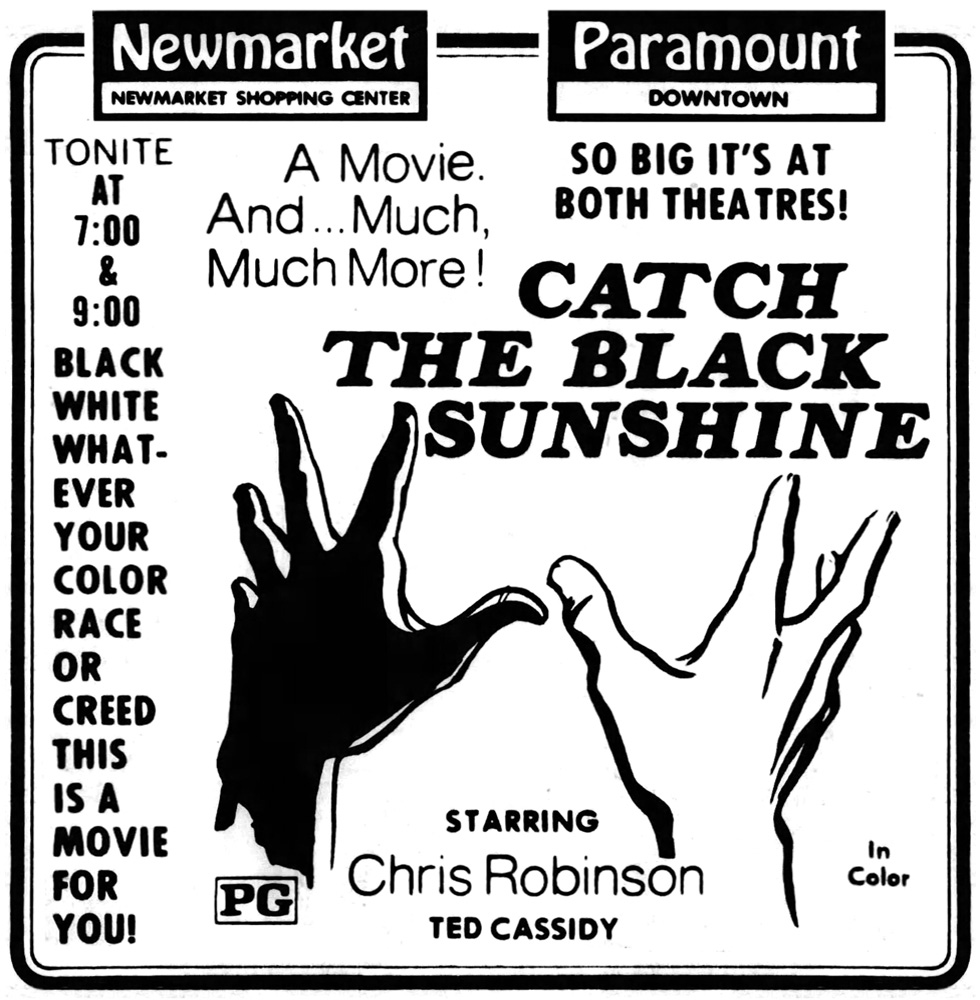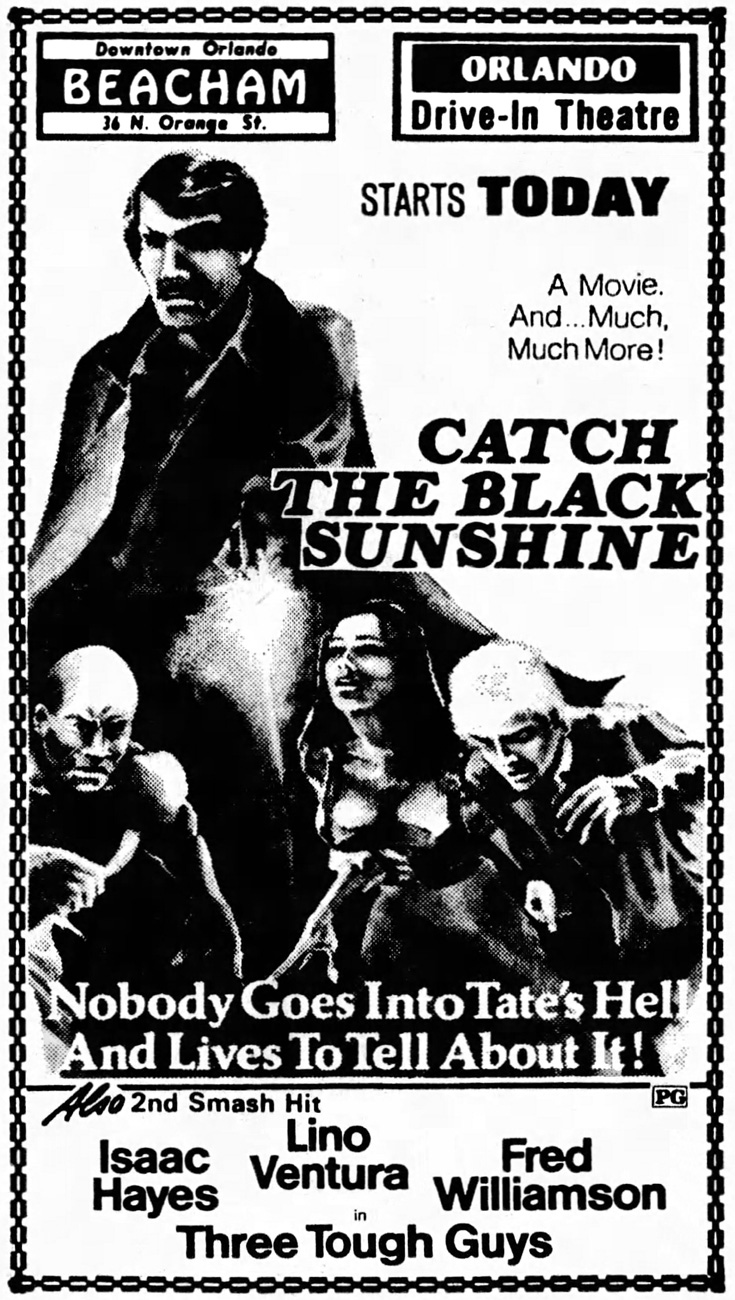|
 Even at the height of his fame, while co-starring on the mid-1960's TV-series 12 O'CLOCK HIGH, Chris Robinson remained a Florida resident and flew back home on the weekends, while his '70s Sunshine State exploitation fare like STANLEY and REVENGE IS MY DESTINY provided a slightly easier commute. So when this Hypoluxo, FL native decided to make his directing/writing/producing feature debut, he filmed it in his proverbial backyard. A 1859 tale of two runaway slaves (initially entitled "Charcoal Black") shot primarily in Florida's Jonathan Dickinson State Park and Tallahassee's Junior Museum. Obviously Robinson had good intentions (or else he wouldn't have self-financed this project by selling shares to local friends and neighbors), but perming and dying his hair white, then casting himself in the lead role of a black, albino, pre-Civil-War-era slave, was only the first of his many missteps... After finding a long-buried treasure map, "white nigger" Sunshine (Robinson) and his bald, bare-chested, physically-imposing brother Levi (Anthony Scott) knock out their towering foreman, Striker (Pensacola native, former local morning radio announcer and ex-"Lurch," Ted Cassidy), and skedaddle on foot into an area known as Tate's Hell. Saddled with a pair of exceptionally grizzled bounty hunters (David Legge and Miami comedian Bob Leslie), Striker pursues these rebellious "bucks" across the mangrove swampland. It's basically one long chase, broken up by asinine encounters. When Sunshine is bitten by a Copperhead, the venom is sucked out by a helpful black family, who only wind up tortured or murdered for their effort; the brothers are beaten up by some in-bred, Even at the height of his fame, while co-starring on the mid-1960's TV-series 12 O'CLOCK HIGH, Chris Robinson remained a Florida resident and flew back home on the weekends, while his '70s Sunshine State exploitation fare like STANLEY and REVENGE IS MY DESTINY provided a slightly easier commute. So when this Hypoluxo, FL native decided to make his directing/writing/producing feature debut, he filmed it in his proverbial backyard. A 1859 tale of two runaway slaves (initially entitled "Charcoal Black") shot primarily in Florida's Jonathan Dickinson State Park and Tallahassee's Junior Museum. Obviously Robinson had good intentions (or else he wouldn't have self-financed this project by selling shares to local friends and neighbors), but perming and dying his hair white, then casting himself in the lead role of a black, albino, pre-Civil-War-era slave, was only the first of his many missteps... After finding a long-buried treasure map, "white nigger" Sunshine (Robinson) and his bald, bare-chested, physically-imposing brother Levi (Anthony Scott) knock out their towering foreman, Striker (Pensacola native, former local morning radio announcer and ex-"Lurch," Ted Cassidy), and skedaddle on foot into an area known as Tate's Hell. Saddled with a pair of exceptionally grizzled bounty hunters (David Legge and Miami comedian Bob Leslie), Striker pursues these rebellious "bucks" across the mangrove swampland. It's basically one long chase, broken up by asinine encounters. When Sunshine is bitten by a Copperhead, the venom is sucked out by a helpful black family, who only wind up tortured or murdered for their effort; the brothers are beaten up by some in-bred,  white-trash hicks at a sawmill; plus late in the film, they meet a lonely young woman (Chris' wife, Phyllis Robinson) living in a stilt-house on the Loxahatchee River. Half-crazed and out of food, she pleads to join the pair on their trek, and is soon making googly-eyes at Sunshine as a sappy romantic melody plays on the soundtrack. Let's not forget its gratuitous, comic-relief chicken-rustling and old-fashioned-bicycle-riding... Alternately incoherent, tedious or downright idiotic, Robinson penned the most ludicrously dramatic moments for himself, amidst excruciating supporting perfs from locally-sourced first-time actors (including top-billed Scott, reportedly discovered by Robinson working in a pancake house) and a corny title tune by Mel ("Hold Me, Thrill Me, Kiss Me") Carter. The actual production must've been hell though, since the leads spend much of the film trudging through remote, waist-deep swamps, and Robinson even took advantage of a sudden, passing hurricane by working it into the story. Admittedly, cinematographer Thomas Spalding (who also shot Mark IV Christian claptrap like WHITCOMB'S WAR and HAPPINESS IS...) captures some picturesque nature backgrounds along the way, using only natural light, but it's the unintentional laughs and general ineptitude that you'll remember most about this astoundingly ill-conceived vanity project. white-trash hicks at a sawmill; plus late in the film, they meet a lonely young woman (Chris' wife, Phyllis Robinson) living in a stilt-house on the Loxahatchee River. Half-crazed and out of food, she pleads to join the pair on their trek, and is soon making googly-eyes at Sunshine as a sappy romantic melody plays on the soundtrack. Let's not forget its gratuitous, comic-relief chicken-rustling and old-fashioned-bicycle-riding... Alternately incoherent, tedious or downright idiotic, Robinson penned the most ludicrously dramatic moments for himself, amidst excruciating supporting perfs from locally-sourced first-time actors (including top-billed Scott, reportedly discovered by Robinson working in a pancake house) and a corny title tune by Mel ("Hold Me, Thrill Me, Kiss Me") Carter. The actual production must've been hell though, since the leads spend much of the film trudging through remote, waist-deep swamps, and Robinson even took advantage of a sudden, passing hurricane by working it into the story. Admittedly, cinematographer Thomas Spalding (who also shot Mark IV Christian claptrap like WHITCOMB'S WAR and HAPPINESS IS...) captures some picturesque nature backgrounds along the way, using only natural light, but it's the unintentional laughs and general ineptitude that you'll remember most about this astoundingly ill-conceived vanity project.
© 2018 by Steven Puchalski.

|